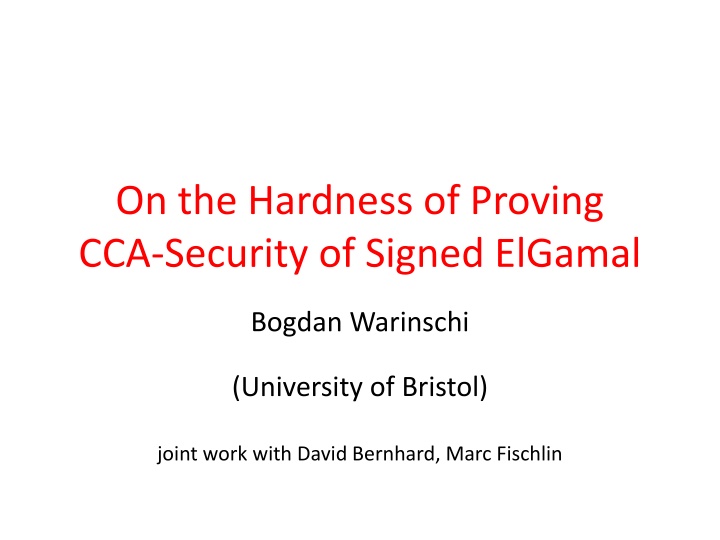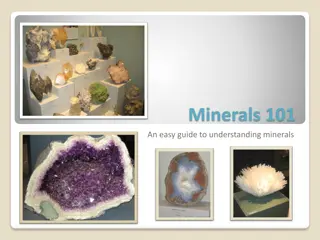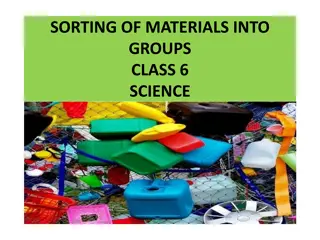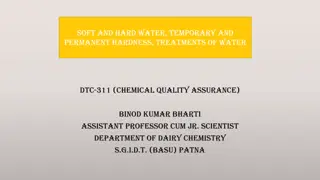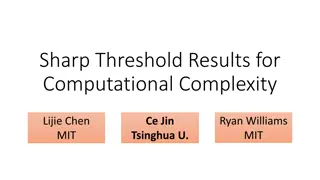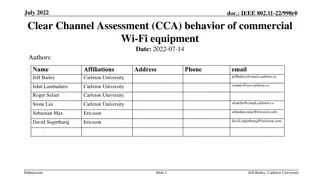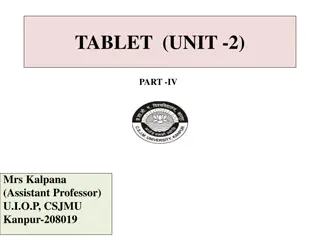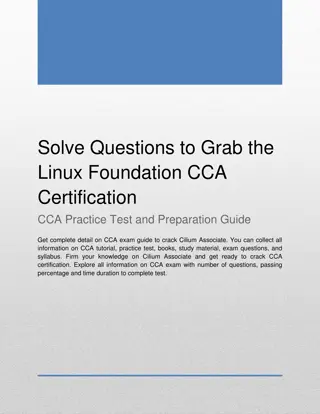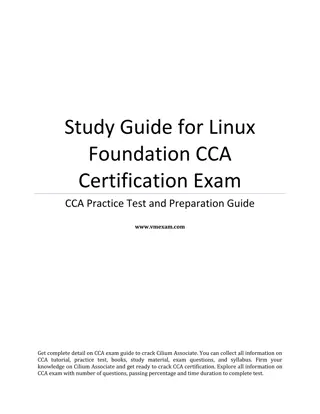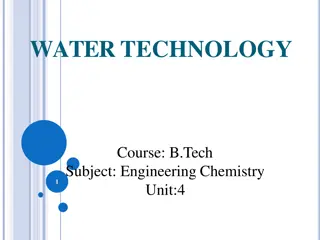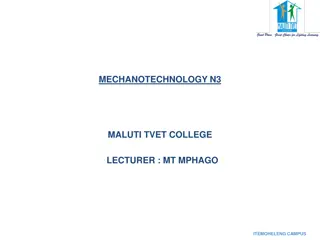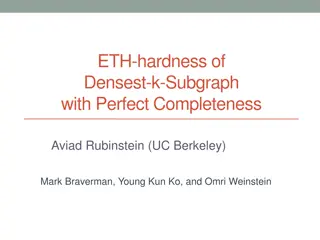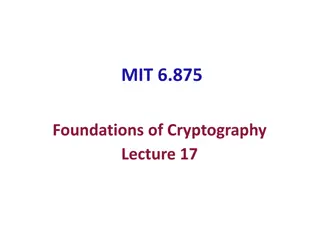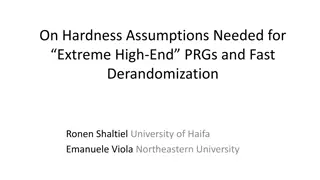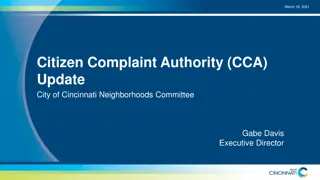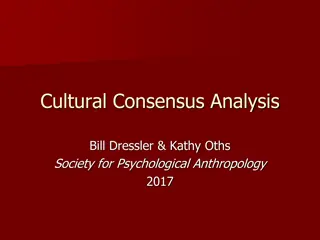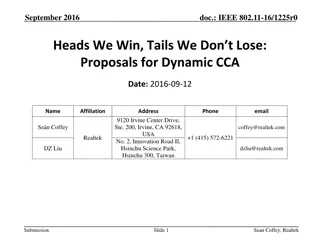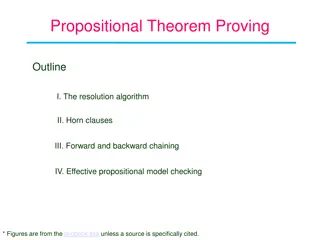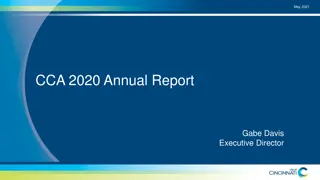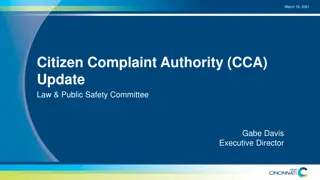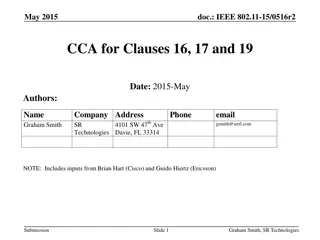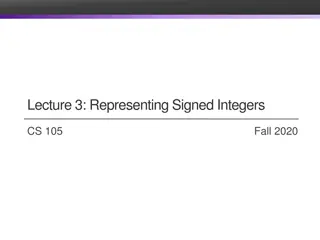Hardness of Proving CCA-Security in Signed ElGamal
Bogdan Warinschi from the University of Bristol, along with David Bernhard and Marc Fischlin, discusses the challenges in proving the chosen-ciphertext security of signed ElGamal encryption schemes. The potential solution involves adding a proof of knowledge to ciphertexts to prevent adversaries from gaining valuable information through decryption queries. Schnorr signatures are proposed as a mechanism for demonstrating knowledge in ElGamal encryption. The Fiat-Shamir heuristic is suggested for eliminating interactions in the verification process.
Download Presentation

Please find below an Image/Link to download the presentation.
The content on the website is provided AS IS for your information and personal use only. It may not be sold, licensed, or shared on other websites without obtaining consent from the author.If you encounter any issues during the download, it is possible that the publisher has removed the file from their server.
You are allowed to download the files provided on this website for personal or commercial use, subject to the condition that they are used lawfully. All files are the property of their respective owners.
The content on the website is provided AS IS for your information and personal use only. It may not be sold, licensed, or shared on other websites without obtaining consent from the author.
E N D
Presentation Transcript
On the Hardness of Proving CCA-Security of Signed ElGamal Bogdan Warinschi (University of Bristol) joint work with David Bernhard, Marc Fischlin
El Gamal encryption public key = X = gx encryption: Enc(X,m;r) = (R,D) = ( gr, Xr m ) secret key = sk =x decryption: Dec(x,(R,D)) = D / Rx = Xr m / (gr)x = (gx)r m / (gr)x = m
Chosen-Plaintext Security b Generate sk,pk pk m0, m1 C Adversary C=Enc(pk,mb) d d=b? For ElGamal: IND-CPA DDH [Tsiounis and Yung, PKC 98]
Chosen-Ciphertext Security b pk Generate sk,pk C m m=Dec(sk,C) m0, m1 C* C=Enc(pk,mb) Adversary C m ElGamal not IND-CCA: m=Dec(sk,C*) (R,D) = (gr, pkr m) (R*,D*) = (R gs, D pks) = (gr+s, pkr+s m) d=b? d
Potential Solution Add proof of knowledge to ciphertext: (R,D, ) = ( gr, pkr m , ) proof of knowledge I know exponent r idea: for any decryption query (R*,D*) adversary already knows r* could decrypt herself as R* / pkr*= pkr* m* / pkr*= m* decryptions of other ciphertexts do not help to learn something about original message m
Schnorr Signatures obvious candidate for proof of knowledge for El Gamal encryption are Schnorr signatures [S 91] knows r to R=gr pick random a compute A=ga knows R A c pick random challenge c compute s=a+cr s check ARc=gs
Proof of Knowledge Property from verification equations: R-cgs = A = R-c*gs* knowledge of r shown via r = (s*-s) / (c*-c) knows r to R=gr pick random t compute A=ga knows R A c pick random challenge c* pick random challenge c c* compute s=a+cr compute s* s s* check ARc*=gs* check ARc=gu
Removing Interaction [FS86] Fiat-Shamir heuristic: assume good hash function H ( random oracle model ) knows r to R=gr pick random a compute A=ga compute c=H(R,A) knows R A c pick random challenge c compute s=a+cr s , check ARc=gs for c=H(R,A)
Signed El Gamal encryption public key = X = gx secret key = x encryption: Enc(X,m;r) = (R,D,A,s) = ( gr, Xr m , ga, a + r c) where c=H(X,R,D,A) decryption: decrypt only if valid proof
Signed ElGamal & CCA-Security? Bernhard et al. (AC 12): NM-CPA secure This paper: No bbox* reduction from IND-CCA to IND-CPA security of ElGamal, unless IES easy Seurin, Treger (CT-RSA 13): Not Plaintext-aware Bernhard et al. (PKC 15): An instance of Enc+PoK PoK, not good enough to prove CCA Tsiounis & Yung (PKC 98) + Schnorr & Jakobsson (AC 00) + Abdalla, Benhamouda, MacKenzie (S&P 15) both show CCA-security of signed ElGamal (DDH+ROM) additionally require knowledge-of-exponent assumption or additionally require generic group model or algebraic adversaries
We study key-passing, bbox reductions (from CCA to CPA of Signed El Gamal) Adversary b x, X=gx Adversary X Reduction m0, m1 gr, Xr mb d d=b? Adversary
Interactive Signed ElGamal (IES) X=gx, R=gr, A=ga X,R,A c s = a + r c Adversary M M=gxr ? IES assumption: no efficient adversary can guess gxr
One-more Interactive verified Signed ElGamal (OMvIES) X X=gx R1=gr1, A1=ga1 M=gx r1 ? Adversary R1=gr2, A1=ga2 M=gx r2 ? R1=grn, A1=gan M=gx rn
One-more Interactive verified Signed ElGamal (OMvIES) X=gx R1,A1 c a1 + r1 c R1=gr1, A1=ga1 R1=gr1, A1=ga1 M=gx r1 ? c* a1 + r1 c* M=gx r1 ? Adversary M? R1=gr2, A1=ga2 M=gx r2 ? The adversary breaks OMvIES if it can guess gxr for an *unopened* IES instance R1=grn, A1=gan M=gx rn
We study key-passing, bbox reductions Adversary b x, X=gx Adversary X Reduction m0, m1 gr, Xr mb d d=b? Adversary
A very bad adversary ci=H(X,Ri,Di,Ai) given Adversary Create n malicious ciphertexts Ci=(Ri,Di,Ai,si=ai+rici) Select H(X,Ri+1,Di+1,Ai+1)? Ri+1,Di+1,Ai+1 as f(ci) ci+1 Issue decryption queries Ci+1=(Ri+1,Di+1,Ai+1,si+1) with si+1=ai+1+ri+1ci+1 Break ElGamal- Schnorr
A very bad adversary ci=H(X,Ci,Di,Ai) given Adversary Create n malicious ciphertexts Ci=(Ri,Di,Ai,si=ai+xci) Select H(X,Ci+1,Di+1,Ai+1)? Ri+1,Di+1,Ai+1 as f(ci) ci+1 Issue decryption queries Ci+1=(Ri+1,Di+1,Ai+1,si+1) with si+1=ai+1+xci+1 Check Mn Decrypt Cn Mn Break ElGamal- Schnorr Decrypt C1 M1 Check M1
Intuition 1. If no copy of the adversary reaches the break ElGamal stage the reduction breaks IND-CPA on its own 2. If some copy reaches the break ElGamal stage and IES is hard, then it must open all IES instances involved 3. To open all instances, the reduction needs to simulate 2n copies of the adversary Adversary Create ciphers Decrypt in reverse Break ElGamal b Adversary Create ciphers x, X=gx X Decrypt in reverse Reduction Break ElGamal m0, m1 gr, Xr mb d Adversary Create ciphers d=b? Decrypt in reverse Break ElGamal
Given a reduction Adversary b x, X=gx Adversary X Reduction m0, m1 gr, Xr mb d d=b? Adversary
construct a metareduction Breaks OMvIES X=gx R1=gr1, A1=ga1 Reduces CCA to CPA M=gx r1 ? R1=gr2, A1=ga2 M=gx r2 ? Reduction R1=grn, A1=gan M=gx rn
Metareduction X=gx R1=gr1, A1=ga1 Simulated adversary copy M=gx r1 ? R1=gr2, A1=ga2 M=gx r2 ? Reduction Simulated IND-CPA game for ElGamal Simulated adversary copy R1=grn, A1=gan M=gx rn
Metareduction X=gx R1=gr1, A1=ga1 Simulated adversary copy M=gx r1 ? R1=gr2, A1=ga2 M=gx r2 ? Reduction Simulated IND-CPA game for ElGamal Simulated adversary copy R1=grn, A1=gan M=gx rn
Simulated ciphertexts X=gx R1, A1 H(X,R1,D, A1) Select random D R1=gr1, A1=ga1 c R1=gr1, A1=ga1 M=gx r1 ? s Reduction M=gx r1 ? C=(R1,D,A1,s1) R1=gr2, A1=ga2 M=gx r2 ? R1=grn, A1=gan M=gx rn
Simulated ciphertexts maintaining consistency X=gx R1, A1 H(X,R1,D1, A1) Select random D1 R1=gr1, A1=ga1 c1 R1=gr1, A1=ga1 M=gx r1 ? s1 Reduction M=gx r1 ? C1=(R1,D1,A1,s1) R2, A2 R1=gr2, A1=ga2 H(X,R2,D2, A2) Select random D2 c2 M=gx r2 ? s2 C2=(R2,D2,A2,s2) R1=grn, A1=gan Compute ciphertexts, depending on what the reduction provides at this interface M=gx rn
Simulated ciphertexts checking decryption queries X=gx R1, A1 H(X,R1,D1, A1) Select random D1 R1=gr1, A1=ga1 c1 R1=gr1, A1=ga1 M=gx r1 ? s1 M=gx r1 ? C1=(R1,D1,A1,s1) Reduction R1=gr2, A1=ga2 M=gx r2 ? C1=(R1,D1,A1,s1) If M is the correct decryption and the IES instance was not M=D1/M1 M1 R1=grn, A1=gan opened, then the metareduction breaks OMvIES M=gx rn
Conclusion Proof of IND-CCA for Signed ElGamal unlikely to be a reduction to IND-CPA security of ElGamal IES is plausible, so the only way around is either non-blackbox reduction or non-key passing (e.g. directly to DDH?) Thanks for your attention
